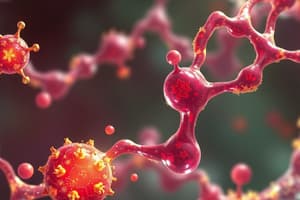Podcast
Questions and Answers
What is the study of enzymes called?
What is the study of enzymes called?
- Enzymatics
- Enzymology (correct)
- Enzymogeny
- Enzymopathy
What is the main function of enzymes in biochemical processes?
What is the main function of enzymes in biochemical processes?
- Promoting protein degradation
- Catalyzing chemical reactions (correct)
- Inhibiting metabolic events
- Stimulating RNA synthesis
What is the diagnostic and prognostic importance of enzymes in medicine?
What is the diagnostic and prognostic importance of enzymes in medicine?
- They are only used for treatment
- They have diagnostic and prognostic significance (correct)
- They are harmful to the body
- They are irrelevant in medical diagnosis
How do enzymes affect the rate of biochemical reactions?
How do enzymes affect the rate of biochemical reactions?
Which type of enzymes are formed at a constant rate?
Which type of enzymes are formed at a constant rate?
What is the most effective enzyme that converts 40 million molecules of H2O2 into O2 and H2O in 1 second?
What is the most effective enzyme that converts 40 million molecules of H2O2 into O2 and H2O in 1 second?
Which model explains enzyme-substrate specificity by describing a complementary fit between the enzyme and substrate?
Which model explains enzyme-substrate specificity by describing a complementary fit between the enzyme and substrate?
How many amino acids are directly involved in catalysis at the catalytic site of enzymes?
How many amino acids are directly involved in catalysis at the catalytic site of enzymes?
What is the basis for enzyme nomenclature?
What is the basis for enzyme nomenclature?
Which classification of enzymes is based on their catalytic activity?
Which classification of enzymes is based on their catalytic activity?
What influences enzyme function and is essential for catalytic activity?
What influences enzyme function and is essential for catalytic activity?
What are physically distinct forms of the same enzyme, differing in quaternary structure, kinetic parameters, and distribution in tissues and organs?
What are physically distinct forms of the same enzyme, differing in quaternary structure, kinetic parameters, and distribution in tissues and organs?
How are enzymes regulated through factors like temperature, pH, substrate concentration, allosteric regulation, covalent modification, and enzyme concentration?
How are enzymes regulated through factors like temperature, pH, substrate concentration, allosteric regulation, covalent modification, and enzyme concentration?
What type of enzymes are formed only in the presence of their substrate or a similar substance?
What type of enzymes are formed only in the presence of their substrate or a similar substance?
What is the term for the unique name and code assigned to each enzyme?
What is the term for the unique name and code assigned to each enzyme?
What describes the significantly faster rate of enzyme-catalyzed reactions compared to uncatalyzed reactions?
What describes the significantly faster rate of enzyme-catalyzed reactions compared to uncatalyzed reactions?
Flashcards are hidden until you start studying
Study Notes
Enzyme Properties and Classification Summary
- Enzymes bind substrates through various interactions like electrostatic, hydrophobic, and Van der Waals interactions, forming enzyme-substrate complexes.
- Constitutive enzymes are formed at a constant rate, while inducible enzymes are formed only in the presence of their substrate or a similar substance.
- Enzyme-catalyzed reactions are significantly faster (103-1020 times) than uncatalyzed reactions.
- Catalase is the most effective enzyme, converting 40 million molecules of H2O2 into O2 and H2O in 1 second.
- Enzymes are not consumed or permanently modified in reactions and exhibit absolute specificity for substrates.
- Enzyme action models include the Fischer "lock and key" model and the Koshland induced fit model, explaining enzyme-substrate specificity.
- Enzymes are large globular proteins with 2-4 amino acids directly involved in catalysis at the catalytic site.
- Enzyme nomenclature is based on the type of reaction, substrate, product, origin site, and mechanism of effect, with each enzyme having a unique name and code (EC code number).
- Enzymes are classified into several classes based on their catalytic activity, including oxidoreductases, transferases, hydrolases, lyases, isomerases, and ligases.
- Enzyme function is influenced by cofactors, coenzymes, and prosthetic groups, which are essential for catalytic activity.
- Isoenzymes are physically distinct forms of the same enzyme, differing in quaternary structure, kinetic parameters, and distribution in tissues and organs.
- Enzyme regulation occurs through factors like temperature, pH, substrate concentration, allosteric regulation, covalent modification, and enzyme concentration.
Studying That Suits You
Use AI to generate personalized quizzes and flashcards to suit your learning preferences.




